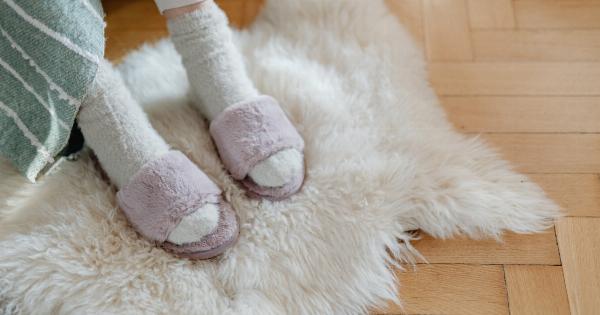There is nothing more frustrating than having an itchy toe, especially if it’s persistent over a long period of time. It can disrupt your daily activities, hinder your sleep, and even lead to pain.
It is important to understand the reasons why your toes might be itching. Let’s explore the most common causes of toe itching, and the various treatments available for each specific cause.
1. Athlete’s Foot (Tinea Pedis)
Athlete’s foot is a fungal infection that can occur anywhere on the feet, including between the toes. It can make the skin dry, scaly, and itchy.
Athlete’s foot is highly contagious and can be spread through direct contact with an infected person, their clothing or footwear. Keeping your feet dry and clean can prevent the occurrence of Athlete’s Foot. Wearing open-toed shoes, changing socks frequently, and drying your feet after washing are essential preventative measures.
Treatment of Athlete’s Foot includes the use of antifungal creams and powders that are available over the counter. In more severe cases, oral antifungal medication may be required.
2. Toe Fungus (Onychomycosis)
Toenail fungus, also known as onychomycosis, can also cause itching, as well as discoloration and thickening of the toenails. Nail fungus is a common condition caused by an overgrowth of fungi on, under, or around the nails.
It can appear in both fingernails and toenails but is more commonly seen in toenails. Keep your toenails clean and trimmed to avoid chances of infection. Treatment for toe fungus includes antifungal pills, antifungal nail polish, and antifungal medicated nail creams.
3. Psoriasis
Psoriasis is a skin condition that causes thick, scaly patches on the surface of the skin. These patches can be itchy, inflamed, and painful, and may appear on the toes and feet.
It is an autoimmune disorder in which the cells build up rapidly on the surface of the skin. It can be aggravated by stress, smoking, or exposure to cold temperatures. Depending on the severity of the itch, a dermatologist may recommend topical creams, ointments, and light therapy or oral medications to treat this condition.
4. Eczema
Eczema, also known as atopic dermatitis, is a chronic inflammatory skin condition characterized by red, itchy, and scaly patches. It is known to affect the hands and feet and can cause itching, peeling, and redness.
Keeping the feet moisturized and protected from irritants can prevent complications from Eczema. Treatment of Eczema includes the use of antihistamines to reduce itching, topical corticosteroids to reduce inflammation, and prescription-strength moisturizers to soothe and hydrate the skin.
5. Contact Dermatitis
Contact Dermatitis is a condition caused by exposure to an irritant or allergen that irritates the skin. The skin on the feet can become itchy, red, and inflamed. Common irritants include certain materials in socks or shoes, soaps, and detergents.
The only cure for Contact Dermatitis is to avoid the irritants, and it commonly goes away after contact with these irritants stops. Over-the-counter topical creams and ointments may ease the discomfort associated with Contact Dermatitis.
6. Insect Bites
Insect bites are a common cause of itching, especially during the summer months. Bites from mosquitoes, fleas, and bed bugs can cause severe itching and discomfort.
Keeping the toenails trimmed and wearing protective shoes is essential to avoid insects from hibernating in them. Avoid itching the bites to prevent infection and worsening of the symptoms. Use of topical antihistamines and hydrocortisone may alleviate the itch associated with it.
7. Dry Skin
Dry skin is a common condition that often leads to itching. It can cause flaky, itchy, and scaly patches, especially on the feet.
Keeping your feet moisturized, avoiding hot showers, and use of petroleum jelly or moisturizer after washing the feet can help prevent dry skin. Treatment for Dry Skin includes use of OTC moisturizers such as creams and petroleum jelly. Prevention is always better than cure and it is best to take precautionary measures to avoid dry skin.
8. Stress
Stress can manifest itself in several different ways, including through physical symptoms such as itching. It can affect your body’s immune system, leading to a wide range of skin disorders.
Methods to manage stress are vital, and they include exercise, meditation, practicing mindfulness, and getting enough sleep. Reducing exposure to stress triggers can prevent complications associated with stress-related itching.
9. Allergies
Allergic reactions to various substances can also cause toe itching. Common allergens include certain soaps, fragrances, and footwear materials. Keeping a record of which causes the itching and trying to avoid them can be helpful.
Consultation with an allergist can help determine the specific allergen that triggers the itching. Avoid the allergen to prevent the itch associated with allergies.
10. Iatrogenic causes
Another less common cause of toe itching is the side effect of some medications. Some medications may have adverse skin reactions, causing itching, redness, or blistering.
Consultation with a physician may be necessary to determine the cause of the itch and to advise on whether it is due to medication. Consultation with a physician is necessary to determine if the side effects of the medications are causing toe itching, changes to dosage, or change in medications may be needed.
Conclusion
Toe itching can be a symptom of many different underlying conditions, from fungal infections to dry skin to stress. It is important to identify the cause of the itch, treat it promptly, and take preventative measures to avoid it in the future.
If you are unsure about the cause of your toe itching or if it is persistent, it is advised you should consult a dermatologist or a healthcare provider to find out the root cause and treat it well.




























